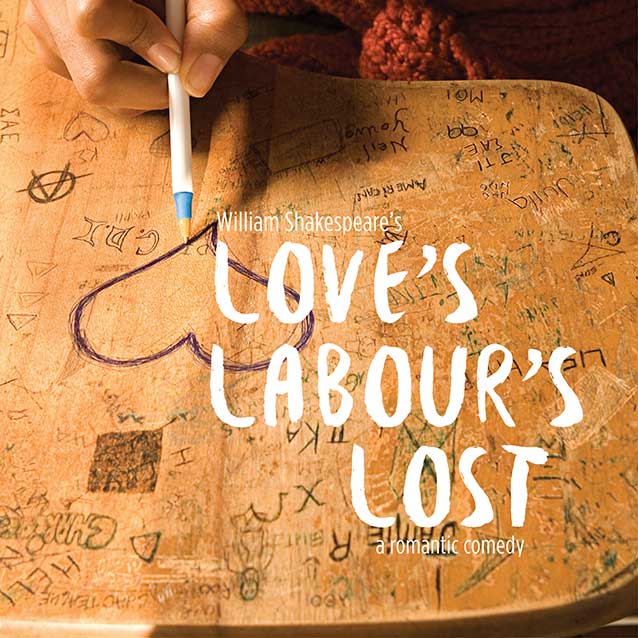Love’s Labour’s Lost, February 2-12 in Norton Theatre
1. Can you give a brief summary of the topics and themes in Love’s Labour’s Lost? Why is this story still relevant to audiences today?
There are two central questions that are most interesting to me in Love’s Labour’s Lost: What does it mean to truly be in love? And, how do we prove to someone that our love is real? At the beginning of the play, we meet four young men who make a pact to forgo all contact with women in order to devote their lives to becoming great scholars. Soon after they swear to each other to live love-free for 3 years, four beautiful young women enter the picture and turn the men’s resolve upside down. But, instead of being open and honest about their feelings for the women, the men enter into a ridiculous series of games meant to woo the ladies, but serve only to lead the women to question the sincerity of the men’s feelings.
The journey of the young lovers in this story is one that I think many of us can relate to! When we are young and in love, we often show off and play games, thinking that this is how we are supposed to act when we are “in love.” As we mature, however, we learn (hopefully!) that to truly be in love means to know and understand someone completely, and to be open and honest about our feelings and desires. Only through mutual respect and vulnerability can we find a meaningful and lasting relationship, and it’s so much fun to watch Shakespeare’s young lovers learn this lesson the hard way!
2. How have you re-imagined this play for modern times? What steps did your cast have
to take to place Shakespeare in the setting of a college campus?
To be honest, setting our production on a present-day college campus wasn’t that difficult to do! Young love is something that certainly permeates the fabric of most college communities, and the main characters in the play are roughly the same age as the student actors who are portraying them. There is a sub-plot in Love’s Labour’s Lost that is also be-fitting of a college campus, involving a silly set of verbose and pompous academics…need I say more?!
3. You are a big advocate for gender parity in theatre. Can you discuss why this is an
issue in the theatre world? What adjustments did you have to make to practice gender
parity in this production?
I am the COO of a non-profit organization called Statera Foundation which supports women theatre artists and is working to achieve gender parity and equity in American Theatre. Through my work with Statera, I have become very aware of the disparity in opportunities that exist for women in professional theatre. A 2016 study conducted by the Wellesley Centers for Women found that in the top regional theatres in the U.S., less than 20% of Artistic Directorships are held by women, with less than 1% being held by women of color. And, as you move down the “chain of command”, the statistics are also disheartening:
- A 2015 study conducted by the Dramatists Guild reported that from 2011 – 2014, only 28% of the plays produced by professional theatres were written by women (and only %2 of those were by women of color),
- And, while national statistics do not exist for other positions (there is a huge need for this research!), there have been several regional studies that further illuminate the gender imbalance. For example, a study produced in the San Francisco Bay Area in 2015 found that only 42% of professional plays were directed by women, and only 40% of union contracts went to female actors.
Statera was created to help support women in the pursuit of their theatre careers by working to remove barriers to growth and achievement, strengthen social and professional networks, and by serving as an advocate to the highest levels of theatre management.
But, while my work with Statera Foundation has taught me just how much there still needs to be done in order to bring women into full and equal representation in American Theatre, I have been so inspired by the amazing theatre artists I have met doing this work, and am encouraged that our mission can be achieved. And while we strive to make impactful change at the highest levels of the theatre world, I am reminded by all those involved in Statera that we must also effect change in our own little corners on the world – and that’s where our production of Love’s Labour’s Lost comes in!
There is a huge interest within the greater Shakespeare community to find ways to simply put more women on stage. As written, Love’s Labour’s Lost has 5 female characters (this is actually more than most Shakespeare plays), but I have done some “gender-bending” with my casting and increased this number to 9. So, with a total of 18 actors, this means we have a cast that is 50% women and 50% men. Thus, gender parity! At UNC, we are working from our little corner of the theatre world to not only add to the growing amount of gender-parity work being done, but we are training the professional theatre artists of tomorrow to enter into and contribute to an American Theatre landscape that tells ALL of our stories, in ALL of our voices.
4. Anything else you would like to share with audiences about this production?
One of Shakespeare’s earliest comedies, Love’s Labor’s Lost sparkles with the antics of young lovers, befuddled intellectuals, and lustful infatuations.
With a surprising note of melancholy at its conclusion, this production is sure to
please relationship realists and hopeless romantics alike. I hope you’ll come see
it!



